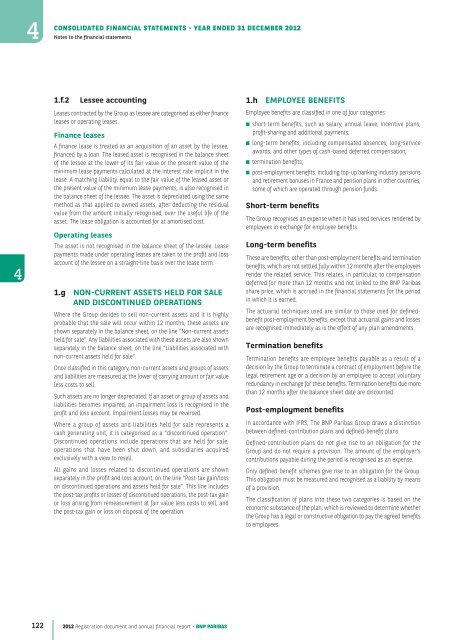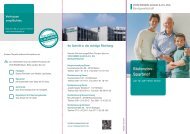2012 Registration document and annual financial report - BNP Paribas
2012 Registration document and annual financial report - BNP Paribas
2012 Registration document and annual financial report - BNP Paribas
- No tags were found...
Create successful ePaper yourself
Turn your PDF publications into a flip-book with our unique Google optimized e-Paper software.
4CONSOLIDATEDFINANCIAL STATEMENTS - YEAR ENDED 31 DECEMBER <strong>2012</strong>Notes to the <strong>financial</strong> statements41.f.2Lessee accountingLeases contracted by the Group as lessee are categorised as either financeleases or operating leases.Finance leasesA finance lease is treated as an acquisition of an asset by the lessee,financed by a loan. The leased asset is recognised in the balance sheetof the lessee at the lower of its fair value or the present value of theminimum lease payments calculated at the interest rate implicit in thelease. A matching liability, equal to the fair value of the leased asset orthe present value of the minimum lease payments, is also recognised inthe balance sheet of the lessee. The asset is depreciated using the samemethod as that applied to owned assets, after deducting the residualvalue from the amount initially recognised, over the useful life of theasset. The lease obligation is accounted for at amortised cost.Operating leasesThe asset is not recognised in the balance sheet of the lessee. Leasepayments made under operating leases are taken to the profit <strong>and</strong> lossaccount of the lessee on a straight-line basis over the lease term.1.g NON-CURRENT ASSETS HELD FOR SALEAND DISCONTINUED OPERATIONSWhere the Group decides to sell non-current assets <strong>and</strong> it is highlyprobable that the sale will occur within 12 months, these assets areshown separately in the balance sheet, on the line “Non-current assetsheld for sale”. Any liabilities associated with these assets are also shownseparately in the balance sheet, on the line “Liabilities associated withnon-current assets held for sale”.Once classified in this category, non-current assets <strong>and</strong> groups of assets<strong>and</strong> liabilities are measured at the lower of carrying amount or fair valueless costs to sell.Such assets are no longer depreciated. If an asset or group of assets <strong>and</strong>liabilities becomes impaired, an impairment loss is recognised in theprofit <strong>and</strong> loss account. Impairment losses may be reversed.Where a group of assets <strong>and</strong> liabilities held for sale represents acash generating unit, it is categorised as a “discontinued operation”.Discontinued operations include operations that are held for sale,operations that have been shut down, <strong>and</strong> subsidiaries acquiredexclusively with a view to resell.All gains <strong>and</strong> losses related to discontinued operations are shownseparately in the profit <strong>and</strong> loss account, on the line “Post-tax gain/losson discontinued operations <strong>and</strong> assets held for sale”. This line includesthe post-tax profits or losses of discontinued operations, the post-tax gainor loss arising from remeasurement at fair value less costs to sell, <strong>and</strong>the post-tax gain or loss on disposal of the operation.1.h EMPLOYEE BENEFITSEmployee benefits are classified in one of four categories:■ short-term benefits, such as salary, <strong>annual</strong> leave, incentive plans,profit-sharing <strong>and</strong> additional payments;■ long-term benefits, including compensated absences, long-serviceawards, <strong>and</strong> other types of cash-based deferred compensation;■ termination benefits;■ post-employment benefits, including top-up banking industry pensions<strong>and</strong> retirement bonuses in France <strong>and</strong> pension plans in other countries,some of which are operated through pension funds.Short-term benefitsThe Group recognises an expense when it has used services rendered byemployees in exchange for employee benefits.Long-term benefitsThese are benefits, other than post-employment benefits <strong>and</strong> terminationbenefits, which are not settled fully within 12 months after the employeesrender the related service. This relates, in particular, to compensationdeferred for more than 12 months <strong>and</strong> not linked to the <strong>BNP</strong> <strong>Paribas</strong>share price, which is accrued in the <strong>financial</strong> statements for the periodin which it is earned.The actuarial techniques used are similar to those used for definedbenefitpost-employment benefits, except that actuarial gains <strong>and</strong> lossesare recognised immediately as is the effect of any plan amendments.Termination benefitsTermination benefits are employee benefits payable as a result of adecision by the Group to terminate a contract of employment before thelegal retirement age or a decision by an employee to accept voluntaryredundancy in exchange for these benefits. Termination benefits due morethan 12 months after the balance sheet date are discounted.Post-employment benefitsIn accordance with IFRS, The <strong>BNP</strong> <strong>Paribas</strong> Group draws a distinctionbetween defined-contribution plans <strong>and</strong> defined-benefit plans.Defined-contribution plans do not give rise to an obligation for theGroup <strong>and</strong> do not require a provision. The amount of the employer’scontributions payable during the period is recognised as an expense.Only defined-benefit schemes give rise to an obligation for the Group.This obligation must be measured <strong>and</strong> recognised as a liability by meansof a provision.The classification of plans into these two categories is based on theeconomic substance of the plan, which is reviewed to determine whetherthe Group has a legal or constructive obligation to pay the agreed benefitsto employees.122<strong>2012</strong> <strong>Registration</strong> <strong>document</strong> <strong>and</strong> <strong>annual</strong> <strong>financial</strong> <strong>report</strong> - <strong>BNP</strong> PARIBAS





